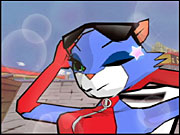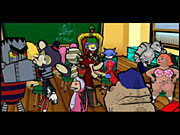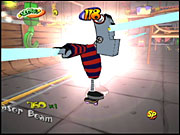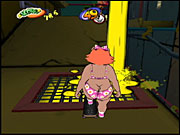Intuitively designed, and visually distinctive, Go! Go! Hypergrind is a pretty interesting game all around. Brought to you by Atlus development house Poponchi, Go! Go! Hypergrind is a skateboarding game based on character designs and animations from Spumco--the animation company fronted by John Kricfalusi--who created such animation cult classics as The Ren & Stimpy Show and the Cartoon Network's The Ripping Friends. While the idea of a skateboarding game based on this style of juvenile gross-out humor may initially seem highly out of place, Go! Go! Hypergrind actually works shockingly well and pans out to be an engaging, if simplistic, skateboarding experience with some legitimately amusing gags and great presentational aspects.

Go! Go! Hypergrind's story and premise is comparable to the plot of the classic Robert Zemeckis film Who Framed Roger Rabbit, but it comes with a decidedly more bizarre spin on the concept. The idea the game puts forth is that animation, in all its forms, is essentially broken up into two categories. There's "real-world" animation, which is created in the traditional way that we know, where animators draw and use computers to animate created characters. The other way involves animated actors from a place called the "Toon World," where cartoon "actors" act out the scripts provided by animation houses. In the game, Go! Go! Hypergrind is actually a new TV show currently in development by Spumco, and the various skaters are cartoon actors trying to get a shot at the leading role in the show.
There are 12 different available skaters in Go! Go! Hypergrind, each with his or her own unique look and design. Some of the more memorable characters include Decker, an "extreme" wolf with sagging jeans and an attitude; Mr. Smith, an irritable monkey with an adorable tuxedo jacket and miniature top hat; Piggy Sue, a bikini-clad oinker with a bit of a weight problem; Sally, a cute little girl who also happens to be a mummy/witch; and the Johnson Bros., a goofy pair with long noses who are stacked on top of one another and share the same sweater. The character designs are very cool and are most definitely representative of the work of Spumco. Each character also has his or her own strengths and weaknesses in the categories of air, ollie, rail, lip, manual, and reaction. Stats are measured on a 1-to-10 point scale. Stat balance doesn't really exist between skaters, and many characters range from being decidedly underpowered to heavily overpowered. However, despite the stat levels, the handling for each of them doesn't feel especially different, so, once you've mastered the basic mechanics of the game, you'll be able to perform just fine with any available skater.
When it comes to the actual skating in Go! Go! Hypergrind, anyone who's played practically any other skateboarding game should be able to pick up the basic skating mechanics with relative ease. Trick categories are broken up into air, flip, grind, manual, and lip tricks. Basic tricks are performed by pressing a direction on the analog stick, along with the appropriate trick button when in the proper situation for a trick. So, for example, when you're in the air, all you need to do is press up and hit the air trick button, and you'll perform one of your skater's air tricks. Every skater also has his or her own list of unique, special tricks, which are performed essentially the same way. The only real difference with special tricks is that they use a character-specific type of animation. For instance, you might see Sally riding a broomstick across a rail during a grind, or you may see the Johnson Bros. doing a goofy dance at the top of a ramp during a lip trick. Special tricks also tend to net you more points, but they take a little longer to execute, so you'll need to time them a little more carefully.
Go! Go! Hypergrind also features an interesting type of trick that plays heavily to the game's cartoon-based image. Each environment in the game contains a host of different gags that can be used by pressing the X button at the proper time. Gag types range from saw blades that decapitate your skater to swinging doors and mechanized flattening devices that fold you up like an accordion. There are also flaming garbage cans that can set you ablaze, and there are even giant plants that will gobble you whole. Rather than count them as simple tricks by themselves, however, executing one of these special gags puts you into a special state that multiplies your score for each trick you perform while in this state. This allows you to link all your tricks (while in this state), thus creating one big combo. Executing these gags is just as simple as any of the other tricks in the game, but it does require some precise timing, which is similar to the special tricks.

These gag tricks are made even better by the excellent and entertaining level design found in Go! Go! Hypergrind. There are eight levels in all to be found in the game, each one modeled after a supposed cartoon movie set. Every stage is chock-full of the usual ramps, rails, and jumps, in addition to the aforementioned gags and hazards. What really makes each level so cool, however, is how you have the ability to string together many of these gags into surprisingly long combinations, which you can use to access secret or otherwise hard-to-reach sections. For example, on the game's "jungle" level, simply skating into a campfire will provide the appropriate fire effect. Then, skating into a nearby pack of dynamite will send you flying into the air and toward a cannon. Hit the X button there, and you'll be sent flying even farther through the air toward a volcano. Hit the X button there, and you'll be sucked into the volcano. Then you'll be spat out in an entirely different direction, and so on and so forth. Not all of these types of combinations are as lengthy as this example, but there's plenty of cool stuff to find in each stage.
In terms of game modes, there, unfortunately, isn't a ton of variety in Go! Go! Hypergrind. The game's primary mode is the story mode, which is also the setup for the game's aforementioned plot. Here, you'll select one of the available skaters, and you'll take him or her through a rigorous competition against the rest of the game's roster to become the Go! Go! Hypergrind champion--and the star of Spumco's new show. Each stage has its own set of competitions, and you'll have to go through about a total of 40 challenges. Competitions range from straight-up point contests to a "Simon Says" type of game where you'll have to perform certain gag tricks in a specific order. All told, the story mode can be completed in a couple of hours, but, in actuality, you'll need to play through it with every character, as each skater has or her own unique cutscenes and endings that can be unlocked. Playing through the story multiple times is the only way to earn enough cash to buy everything in the skate shop.

The skate shop is effectively the game's unlockables mode, and here you can purchase new designs and upgrades for your deck and wheels, as well as a host of different gear types, which become available as you beat each stage. Gear isn't a decorative type of thing, despite the fact that you'll be buying things like backpacks, watches, wristbands, and even laser guns. These items actually provide you with stat upgrades for your skater. For example, buying a barrel will increase every stat on your skater by five. However, many of these items also take away certain stats. One item will bump your ollie stat by nine points, but it'll detract from every other stat by five points as well. It's sort of a bizarre way to go about upgrading skaters, but it does sort of fit with the offbeat nature of the game.
In terms of other modes, the game also lets you perform a free ride as a single timed run, an endless run, or a tutorial run. There's also a versus battle mode where you can compete against another player or the CPU in one of five types of matches, many of which are taken from the story mode's various challenges. There's one unique match called "push" where your goal is to squeeze your opponent off the screen by performing as many gimmick tricks as possible. The multiplayer component of the game definitely adds some longevity and is pretty fun, overall. However, the game is still a bit too much on the simple side to really hold your attention as a single-player experience once you've beaten the story mode and have unlocked all the extras.
With all the recent games that have taken on a cel-shaded look for their graphical designs, it seems only fitting that a game based in a cartoon universe would follow suit. At this point, cel shading may be a bit passé for some people, but Go! Go! Hypergrind uses its cel shading very well. Characters are not only colorful and sharp looking, but they also animate very fluidly, making nearly every trick transition look practically seamless. Skaters also interact very well with all the different elements in each level, and they really show off a lot of polish when skating around. Performance wise, Go! Go! Hypergrind maintains a very steady frame rate and doesn't have many glitches to speak of. Clipping is a problem in certain situations--especially for some of the larger skaters--and there are spots where bailing will cause your skater to temporarily become stuck, but, all in all, these problems are only intermittent and are rarely ever more than a minor annoyance.

The game's sound presentation is extremely solid, though it could prove to be a bit too quirky for some people's tastes. Go! Go! Hypergrind's soundtrack is a very mixed selection of tracks, varying between pop-punk tracks and more level-specific stuff, like the happy jingle that plays in the game's "fantasy" stage. There are even a couple of classical compositions that pop up from time to time. There isn't a ton of voice acting in the game, but what is there is pretty well done and can be quite amusing at times. The in-game effects round out the sound design nicely and feature some wacky, cartoon-inspired effects that mix nicely with the various skateboard-centric sounds. Overall, the game sounds really great but may be a bit too grating if you can't get behind the extremely zany nature of the whole thing.
In fact, that last sentence really sums up Go! Go! Hypergrind. The game's gimmick is very heavily geared toward the Spumco fan base, and, to be more specific, people who like heavy doses of insane, gross-out cartoon humor. However, that's not to say that the game doesn't have appeal beyond its gimmick. As a skateboarding game, Go! Go! Hypergrind is a simple, yet effective, piece of work. The game's heavily stylized--but still impressive--visuals and sound definitely add to the experience. If the very idea of a cartoon-inspired skateboarding game with silly humor doesn't sound appealing, then Go! Go! Hypergrind isn't for you. As far as anybody else is concerned, Go! Go! Hypergrind is an entertaining skateboarding game that serves as a perfect alternative for anyone looking for a non-Tony Hawk skating title for the GameCube.